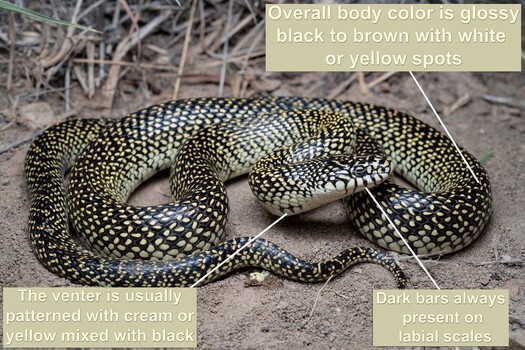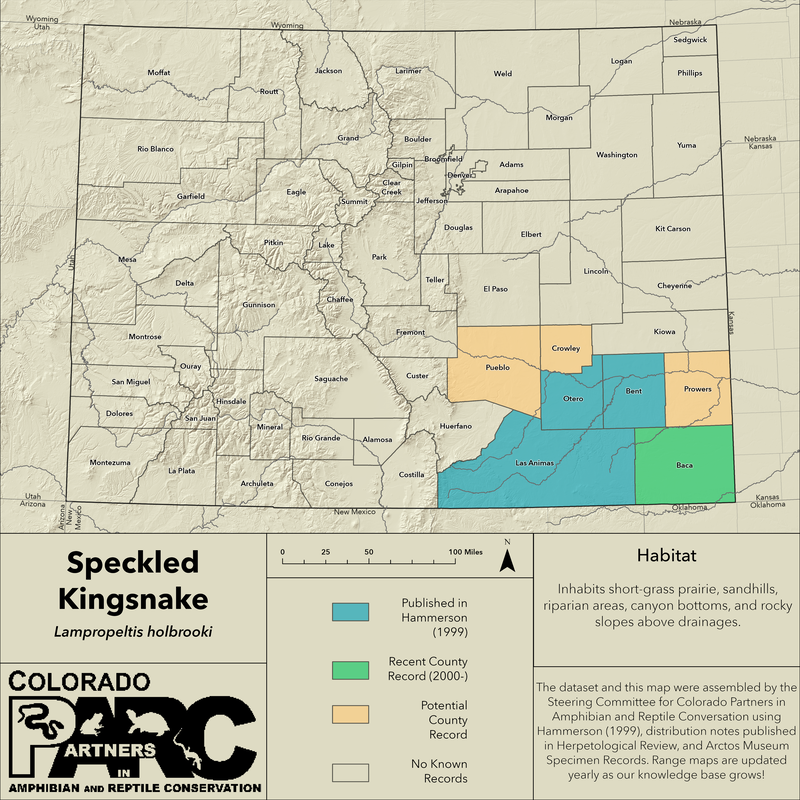Distribution: The Speckled Kingsnake occurs in southeastern Colorado; it has been found at elevations of about 3,800 to 5,000 feet (Hammerson, 1999). They have been documented in Otero, Bent, and Las Animas Counties. Speckled Kingsnake ranges west of the Mississippi from southern Iowa to the Gulf Coast and west through Texas to northeastern Mexico, eastern New Mexico, southeastern Colorado and through most of Kansas (Pyron and Burbrink, 2009).
Activity: Activity likely occurs from late April or May to September or early October. Speckled Kingsnakes can be either nocturnal or diurnal, depending on moisture and temperatures. When inactive, these snakes spend their time underground. Most Speckled Kingsnake activity happens either above ground or in rodent burrows. When inactive, this species may retreat to logs, old buildings, or other types of underground cover (Hammerson, 1999).
Reproduction: L. holbrooki usually reaches sexual maturity at 2 to 4 years of age (Hammerson 1999). Yet, reproductive information is scarce for this species in Colorado. Courtship and mating in Colorado occur mainly in late spring (Hammerson 1999). Males will also prove their dominance over other males by engaging in combative interactions. Mating involves males chasing females until they are caught and mounted. Males then proceed to move forward, rub their chins on the dorsum of females, squirm and grasp the females’ neck in their mouths to hold them still (Ernst and Ernst, 2003). They then curl their tails under the tails of females to begin copulation which may last up to several hours (Hammerson, 1999). Females in the Great Plains region have been reported to lay clutches ranging from 4 to 18 eggs with clutch sizes being generally smaller in the southwestern U.S. (Stebbins 2003). Eggs are usually laid from mid-June to early July and hatching typically happens in mid-to-late August or as late as mid-September (Hammerson 1999). The incubation period ranges from 49-80 days (Hammerson, 1999). Female Speckled Kingsnakes have been observed laying two clutches in one year in captivity (Steppins, 2003).
Size: The Speckled Kingsnake can grow to a total body length (TBL) of 208.3 cm and in Colorado about 183 cm but usually less than 100 cm (Ernst & Ernst 2003). Males have a tail length (TL) making up 11-15% of their TBL. Females have a TL making up 9-13% of their TBL (Ernst & Ernst, 2003).
Habitat: In southeastern Colorado, habitat types for L. holbrooki include: floodplain fields along the Arkansas River, near smaller streams, and other areas that are mostly shortgrass prairie. This species has also been found in rural residential areas surrounded by grasslands (Hammerson, 1999). Elevations where this species occurs over its range vary from sea level to about 5,000 feet (Stebbins, 2003).
Feeding & Diet: The Speckled Kingsnake is an active forager and will hunt for food in burrows, on the ground surface, or in trees. Their wide range of prey includes rodents, birds, bird eggs, lizards, snakes, reptile eggs, and amphibians (Hammerson, 1999). The Speckled Kingsnake also preys on rattlesnakes; its blood serum is effective at neutralizing rattlesnake venom. L. holbrooki constricts its prey with the coils of its body and is so powerful it can constrict other snake species that are larger than the Speckled Kingsnake itself, including other larger constrictors such as the Bullsnake (Hammerson, 1999).
Defenses from Predation: Natural predators include Bullfrogs, Racers, predatory birds (such as golden eagles, red-tailed hawks, and great horned owls) and coyotes. Speckled Kingsnakes have also been known to cannibalize members of their own species (Ernst and Ernst, 2003). L. holbrooki can produce secretions from the cloacal sacs which are thought to be a form of predatory defense. When handled, L. holbrooki often sprays the cloacal secretion, which mammalian predators seem to find unpleasant (Hammerson, 1999). Other defenses this species employs are vibrating its tail, hissing, striking, and biting repeatedly (Ernst and Ernst, 2003).
Cited & Additional Resources
Ernst, C. H., and E. M. Ernst. 2003. Snakes of the United States and Canada. Smithsonian Books, Washington and London. 167 pp.
Hammerson, G. A. 1999. Amphibians and reptiles in Colorado. 2nd ed. University Press of Colorado, Boulder, Colorado. 364 pp.
Pyron, R. A. and F. T. Burbrink. 2009. Systematics of the Common Kingsnake (Lampropeltis getula; Serpentes: Colubridae) and the burden of heritage in taxonomy. Zootaxa 2241:22-32.
Stebbins, R. C. 2003. Western reptiles and amphibians. 3rd ed. Houghton Mifflin Company, New York, New York. 362 pp.
Hammerson, G. A. 1999. Amphibians and reptiles in Colorado. 2nd ed. University Press of Colorado, Boulder, Colorado. 364 pp.
Pyron, R. A. and F. T. Burbrink. 2009. Systematics of the Common Kingsnake (Lampropeltis getula; Serpentes: Colubridae) and the burden of heritage in taxonomy. Zootaxa 2241:22-32.
Stebbins, R. C. 2003. Western reptiles and amphibians. 3rd ed. Houghton Mifflin Company, New York, New York. 362 pp.
Account compiled by: Beth Wittmann
Reviewed by: Lauren Livo and Danny Martin (text)
Last updated: 4/14/2022 by Rémi Pattyn
Reviewed by: Lauren Livo and Danny Martin (text)
Last updated: 4/14/2022 by Rémi Pattyn
Suggested Citation
Colorado Partners in Amphibian and Reptile Conservation. 2015. Species account for Speckled Kingsnake (Lampropeltis holbrooki). Compiled by Beth Wittmann. http://www.coparc.org/speckled-kingsnake.html [accessed date here]. Editors: Lauren Livo and Danny Martin.
Colorado Partners in Amphibian and Reptile Conservation. 2015. Species account for Speckled Kingsnake (Lampropeltis holbrooki). Compiled by Beth Wittmann. http://www.coparc.org/speckled-kingsnake.html [accessed date here]. Editors: Lauren Livo and Danny Martin.



